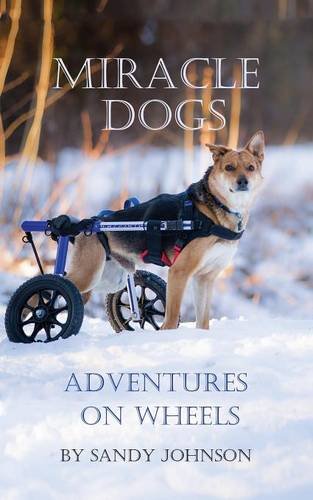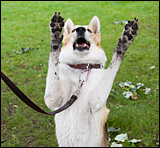
Cindy Cooke has been working with Scotties for over 32 years. The Dog Guide is thrilled to present you with this amazing interview that Cindy was kind enough to give us about her knowledge and experience with Scottish Terriers.
How did you decide that this was the breed for you?
My grandmother rescued a Scottie from negligent neighbors and sent him to me as a birthday present. I thought he was the ugliest little dog I’d ever seen. It was my intention to clean him up and find him another home, but after a week, I couldn’t imagine how I’d ever lived without a Scottie. It was his independent streak that won me over. He loved me, but he had his own ideas about everything.
Can you tell us a bit about the history of your breed?
The breed was developed by poor and thrifty highland Scots who could not afford to allow vermin to threaten their livestock. They developed a small dog who was courageous and powerful enough to tackle most of the local ground-dwelling predators. In the 1870s, Captain W. W. Mackie made a number of trips through the Scottish highlands, buying terriers from the local tod-hunters and taking them back to England. During the next few years, heated arguments appeared in various dog journals on the subject of the Scottish Terrier. For a long time, people could not even agree on the breed’s name (Aberdeen Terrier, Scotch Terrier, Skye Terrier), and any hard-coated dog of a size to go to ground and a sharp temperament was considered to be a Scottie. The first standard was written in 1880, and from that point forward, the breed began to stabilize into the modern Scottish Terrier. In the 1930s, the breed was wildly popular in England and the United States. During WWII, many English breeders sent their best dogs to the United States and the breed improved dramatically as a result. Today, the breed’s popularity has declined somewhat, usually ranking about the 40th most popular AKC breed.
Could you tell us a little bit about the stages of life for this breed?
Scotties usually live 12-13 years. They tend to be very, very active and willful as youngsters, requiring a firm hand and a sense of humor. They are perfect companions as adults. They are as active as you want to be, or as quiet. A Scottish Terrier is not a lapdog. They prefer to enjoy your company from a short distance. In their old age, they are usually still up for a game, but enjoy snoozing quietly the rest of the time. There is nothing quite as dignified and serious as an old Scottie, except at mealtime when he will caper like a puppy.
Describe an average day living with your breed.
No day with a Scottish Terrier is average. Owning a Scottie is less like owning a dog and more like having a really good friend who enjoys being with you, likes a good laugh, disagrees with you on some issues but still thinks you are something special.
Choose a few words that best describe your breed:
Brave, sturdy, independent, loyal.
What are 3 misconceptions about this breed?
Because they are small, and because their outline is so distinctive, people are inclined to think of them as “cute little dogs.” Scotties think of themselves as highland warriors, so they are disinclined to be patted on the head by strangers or treated with condescension. They are inclined to be aggressive with strange dogs, so this is NOT a breed that you can turn out in the dog park. The biggest misconception about Scotties is that females make better pets than males. Most breeders will tell you that the males are more affectionate and easier to train than the females.
What are 3 little known facts about this breed?
Most people think all Scotties are black. In fact, they come in all shades of brindle and wheaten, too. Scotties have jaws and teeth as big as Airedales.
What should people who are interested in this breed know before they bring one of these dogs into their homes?
First, this is NOT a dog for people who want instant obedience. Scotties can be trained, but they will not tolerate a tyrant and they have to be convinced that your rules are reasonable. If you try to teach a Scottie to stay off the sofa, he is likely to learn not to let you SEE him on the sofa. When you come home from work, you will find a warm spot on the sofa as your Scottie greets you from the floor. Second, a certain amount of regular grooming is required to prevent your Scottie looking scruffy. You can learn to do the grooming yourself, or find a good groomer to do the work. Finally, despite his independent nature, a Scottie expects to be included in most family activities. Don’t get a Scottie and expect him to spend all his time by himself. If you do, you will be astonished (and horrified) at the things he will devise to entertain himself
Is there anything interesting that the breeding community (for your breed) is collectively working on?
About 8 years ago, the first case of cerebellar abiotrophy (CA) was diagnosed in a Scottish Terrier. The Scottish Terrier Club of America has done an outstanding job in working to eradicate this newly-identified health problem in our breed. Working with a geneticist and a neurologist, our club provides free diagnosis for any Scottie suspected to have this disorder. In addition, we have a fully-funded research project to find the recessive gene that causes CA. More information about CA can be found on the web at http://www.stca.biz/.
Do you have any tips on how people can go about locating good, quality breeders? What questions or measures would you say to take to weed out a bad breeder?
The Scottish Terrier Club of America has a list of breeders on their web site. Buyers can contact breeders nearest them for help finding a puppy. Breeders don’t always have puppies for sale, but they will be happy to refer prospective buyers to other reputable breeders who DO have puppies for sale. Tips for buying a new puppy:
Do you participate in any activities with your dogs (agility, obedience, earthdog, etc)?
We show our dogs in AKC conformation shows. Responsible breeders generally participate in some activity with their dogs. Buyers should be wary of breeders who do nothing with their dogs except breed them.
Is there anything else you'd like to tell the readers of the Dog Guide about your breed?
Scotties are excellent dogs for school-age children. They are a bit too powerful and low to the ground for toddlers, but once a child is bigger, there’s no better pal than a Scottie.
Thanks to Cindy for the great interview! We encourage Dog Guide readers to visit the Scottish Terrier Breed Club of America for more information about this great breed.

 How to Treat and Prevent Infected Wrinkles in Wrinkly Dog Breeds
In humans, wrinkles are a us
How to Treat and Prevent Infected Wrinkles in Wrinkly Dog Breeds
In humans, wrinkles are a us
 How to Build a Wheelchair for Your Dog
If You Build It, They Will Walk!
How to Build a Wheelchair for Your Dog
If You Build It, They Will Walk!
 Dangers of “Free to Good Home” ads
Dangers of “Free to Good Hom
Dangers of “Free to Good Home” ads
Dangers of “Free to Good Hom
 Dog Tricks – Dog Training Level 2
Dog Tricks – Dog Training Le
Dog Tricks – Dog Training Level 2
Dog Tricks – Dog Training Le
 Important Tips on Choosing and Caring for Our Dogs and Best Friends
How well do you know your do
Important Tips on Choosing and Caring for Our Dogs and Best Friends
How well do you know your do
Copyright © 2005-2016 Pet Information All Rights Reserved
Contact us: www162date@outlook.com